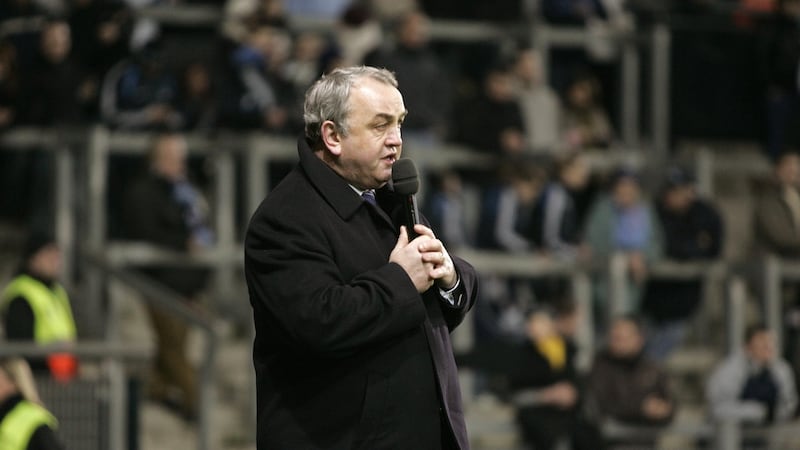This is Michelle O'Neill country. The Sinn Féin deputy leader, hoping to be the North's first minister after Stormont Assembly elections in May, was raised in the staunchly republican heartland.
The Tyrone estate in which she grew up – Coney Park – is named after Hugh Gerard Coney who was shot dead at the age of 24, trying to escape from Long Kesh prison camp in Co Down in 1974.
Coney was one of three former players from Clonoe O'Rahillys GAA club, who died on "active service" with the IRA, says Sinn Féin. A plaque to his memory and that of Peter Clancy and Brian Campbell was unveiled in the Tyrone club's grounds last weekend.

It reads “in proud memory of our fallen Gaels”.
Inevitable controversy erupted when a photograph of O'Neill and other party members, including Mid-Ulster MP Francie Molloy, attending the unveiling was posted by East Tyrone Ógra Shinn Féin on Twitter. The youth wing said the men died "in the struggle for freedom".
Victims groups and unionist politicians decried the event as an attempt to “sanitise” and “normalise” the activities of the IRA during the Troubles. But, locally, some say Sinn Féin, spooked by losing support to “independent republicans” in one its core voter bases, could ill afford to miss out on the publicity weeks before an election is called.
One person who lives in the community, but asked not to be named, said there was "growing support" for independent republicans such as Dan Kerr who took a seat from Sinn Féin in the 2019 local elections, in the Torrent electoral area of Mid Ulster which includes Clonoe.
“Michelle O’Neill turning up was to be expected,” he said. “There is an election in two months’ time. You might even question why it was happening now. Kerr has built up a significant vote and following in and around Clonoe.”
East Tyrone traditionally returns one of the largest Sinn Féin votes outside of west Belfast.
“The amount of [state] collusion that went on here, people take that very personally,” said one local resident. “The fellas commemorated in the plaque were young, and they were on active service; that’s the way people look at it. There was a big, big turnout at the unveiling, both independent republicans and Sinn Féin. They had their own services for it.
“I can see why victims groups have come out against it, and I understand the difficulties around it, but when there is kickback it turns into whataboutery, even among those who may have preferred it not to be sited beside the GAA.
"You hear people talking about banners put up [by unionists] in Moygashell to the Miami Showband killers during the Twelfth."
Peter Clancy (19), was one of four men shot dead by the SAS in what became known as the Clonoe Ambush, in 1992, after they returned from a machine gun attack on Coalisland police station. The elite unit of the British army was lying in wait for them in the hedges around the village’s St Patrick’s Church, where the IRA men had gone to dismantle the machine gun and to continue their escape.
Brian Campbell was also shot dead by the SAS in a field near Clonoe in 1983.
The parish priest at St Patrick's, Fr Benny Fee, said he had not seen the memorial to the three IRA men and knew "nothing about it".
“I wouldn’t make any comment on it,” he said, adding that it had not been mentioned to him by any of his congregation.
Clonoe O’Rahillys tweeted a call out for locals to attend the unveiling of the plaque to the former club members “who made the ultimate sacrifice”.
Club chairman Darren Devlin refused to answer any questions about the memorial, its planning, who it was proposed by, what discussions took place, if any, within the club or with the GAA, and how it was financed. "I'll not be commenting on anything," he said.
GAA headquarters in Croke Park said it respected “the right of any unit of the association to remember its dead members” but added it was “important to recognise the need for sensitivity in such matters”.
The sporting body is working on issuing guidance to clubs and counties “on such events in the future”.

Former GAA president Nicky Brennan, who guided Queen Elizabeth around Croke Park during her ground-breaking state visit to Ireland in 2011, suggested the controversy set back strides made in recent years to foment cross-community relations with the association in the North.
“Things were improving a lot but once this sort of thing happens, it tends to create tensions within communities,” he said.
Brennan, who was president when former DUP leader Edwin Poots and then Stormont sports minister became the first party member to attend a GAA match, in Newry in 2008, said he was "loathe to blame anyone locally" for the fall out.
“It is when politicians get in on the scene and get their photographs taken, it creates an issue and makes it more difficult for the GAA, especially in Ulster where it has made enormous strides in recent years to engage in cross-community engagement and generally has been very successful in doing that,” he said.
“But you’ve got to remember there are very important elections coming up in the North. If clubs are doing it, that is one thing, but when politicians jump on the bandwagon it makes it far more sensitive.”
There was a need for “common sense in having respect for the association and all communities”, he added.
“We can’t forget people who died on both sides, but we have to understand that we are a sporting organisation that struggles to shake off its political attachments.”







